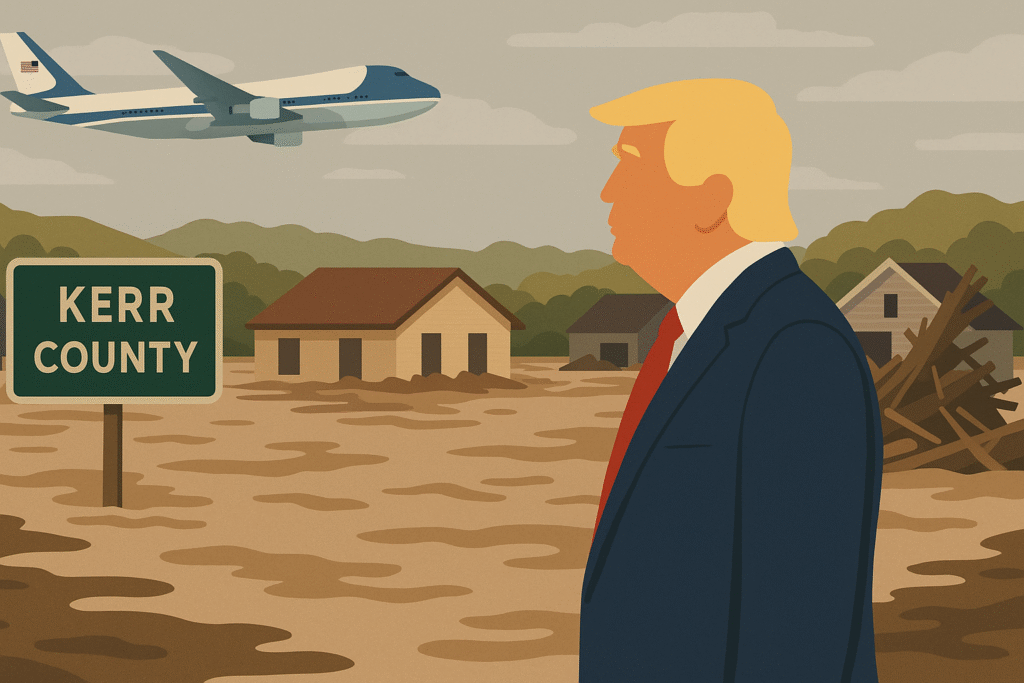President Donald Trump arrived in Texas on Friday to survey the catastrophic damage caused by the devastating floods that swept through the Texas Hill Country on July 4. The floods, which rapidly overwhelmed the Guadalupe River, have resulted in at least 120 confirmed deaths, with 96 fatalities in Kerr County alone, including at least 36 children. More than 160 people remain missing, and rescue teams have not made a live rescue since the day of the flood.
Presidential Visit to Kerr County
President Trump, accompanied by First Lady Melania Trump, landed in Kerr County at approximately 12:20 p.m., where they are meeting with families of the victims, first responders, and local officials. Trump is also participating in a briefing and roundtable with local authorities to discuss the federal and state response.
“It’s a horrible thing,” Trump said before departing Washington aboard Air Force One. “Nobody can even believe it. That much water that fast – without a dam break.”
The president is joined on this visit by Texas Republican Senators Ted Cruz and John Cornyn, Rep. Wesley Hunt, Agriculture Secretary Brooke Rollins, HUD Secretary Scott Turner, and Small Business Administrator Kelly Loeffler.
FEMA Funding and Federal Response
Amid concerns over FEMA’s future, Russ Vought, Director of the White House Office of Management and Budget, confirmed that FEMA has approximately $13 billion in reserves, which will be used to support flood recovery efforts in Texas.
“The president has said to Texas: anything it needs, it will get,” Vought stated. He also emphasized the administration’s desire to reform FEMA to make it more responsive.
Meanwhile, DHS Secretary Kristi Noem reiterated her controversial stance calling for FEMA to be “eliminated in its current form” and restructured to emphasize local and state control over emergency management.
Emotional Support Line Launched for Survivors
Texas Governor Greg Abbott announced the launch of the Texas Flooding Emotional Support Line, a 24/7 free counseling service for survivors, first responders, and affected families. The hotline offers professional crisis counseling, disaster recovery guidance, and mental health referrals.
“This new statewide crisis support line will ensure survivors, families, and first responders have access to emotional support as they work to heal and recover,” said Abbott.
$30 Million Raised for Kerr County Relief
The Community Foundation of the Texas Hill Country has raised over $30 million through the Kerr County Flood Relief Fund, with Texas Rep. Chip Roy expressing gratitude and urging continued donations to aid long-term recovery.
“We’re going to rebuild and we’re going to be back better than ever,” Roy stated.
Missed Warning System Funding Raises Questions
Public scrutiny has intensified after revelations that Kerr County’s 2017 and 2018 applications for a $1 million grant to improve its flood warning system were denied by the Texas Division of Emergency Management. The proposal included upgrades to 20 water gauge systems, new sensors, and a real-time public alert platform.
Despite renewed efforts after Hurricane Harvey in 2018, the state agency rejected the application again. Officials have yet to provide a detailed explanation for the denial.
Search and Recovery Continue
Authorities are urging residents to avoid disturbing large debris piles, which may still contain victims. Search crews are focusing on tangled wreckage along the Guadalupe River and across Kerr County.
Remembering the Victims
Among the 120 flood victims are:
-
A beloved director of a girls’ summer camp.
-
Two young sisters found together after being swept away.
-
A 23-year-old police officer celebrating the holiday with family.
Deaths have been reported in at least six counties, including:
-
Kerr County: 96 deaths
-
Kendall County: 8
-
Travis County: 7
-
Burnet County: 5
-
Williamson County: 3
-
Tom Green County: 1
Looking Ahead
President Trump, in a recent interview, described the flooding as a “once-in-every-200-year” event and voiced support for implementing alarm systems to better warn communities in future disasters.
As the state prepares for a special legislative session, Governor Abbott has pledged to prioritize flood warning system improvements, disaster communications, and emergency preparedness reforms.



